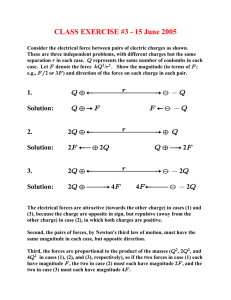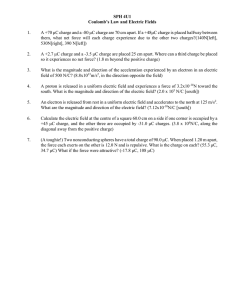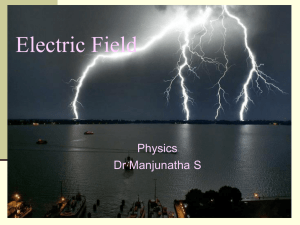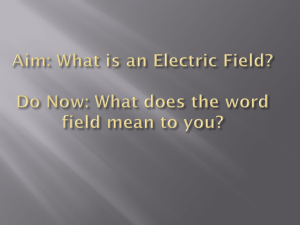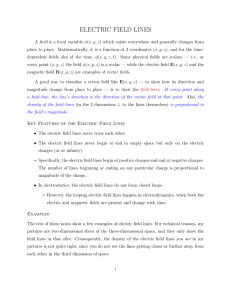Chapter 19: Electric Charges, Forces, and Fields ( )( )( ) ( ) ) ( ) ( )( )
advertisement
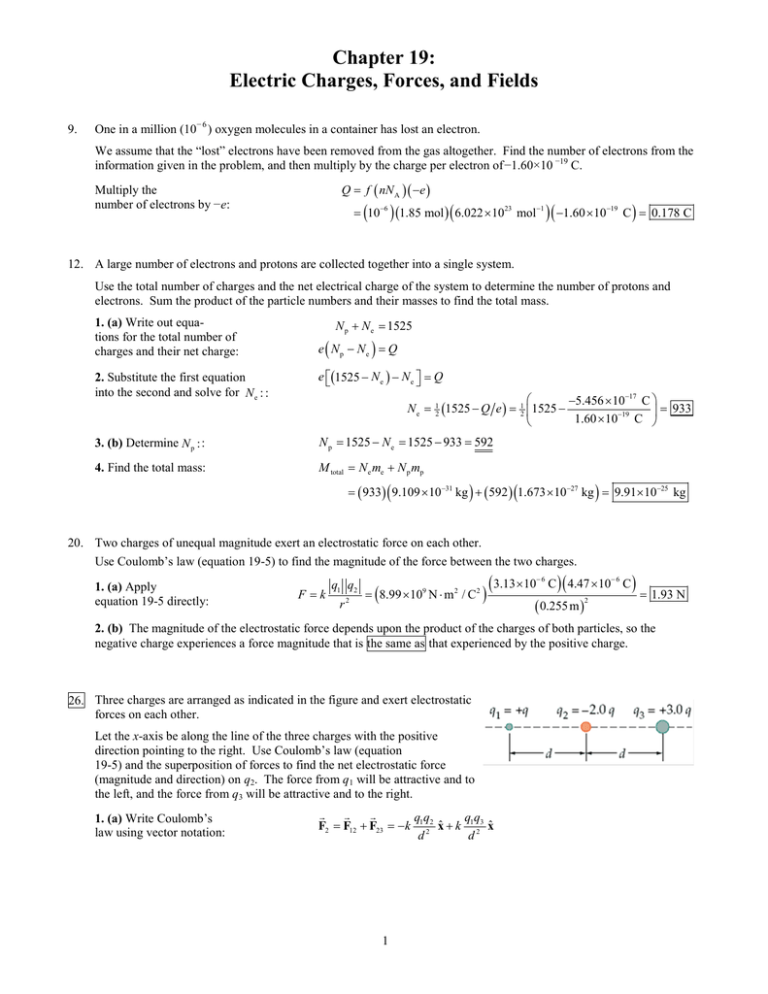
Chapter 19: Electric Charges, Forces, and Fields 9. One in a million (10− 6 ) oxygen molecules in a container has lost an electron. We assume that the “lost” electrons have been removed from the gas altogether. Find the number of electrons from the information given in the problem, and then multiply by the charge per electron of −1.60×10 −19 C. Multiply the number of electrons by −e: Q f ( nN A )( −e ) = = (10 ) (1.85 mol ) ( 6.022 ×10 −6 23 mol−1 = )( −1.60 ×10−19 C ) 0.178 C 12. A large number of electrons and protons are collected together into a single system. Use the total number of charges and the net electrical charge of the system to determine the number of protons and electrons. Sum the product of the particle numbers and their masses to find the total mass. 1. (a) Write out equations for the total number of charges and their net charge: 2. Substitute the first equation into the second and solve for N e : : Np + Ne = 1525 e ( Np − Ne ) = Q e (1525 − N e ) − N e = Q Ne = 1 2 (1525 − Q e )= 3. (b) Determine N p : : N p = 1525 − N e = 1525 − 933 = 592 4. Find the total mass: M N e me + N p mp = total 1 2 −5.456 × 10−17 C 1525 − = 933 1.60 × 10−19 C 9.91× 10−25 kg = ( 933) ( 9.109 ×10−31 kg ) + ( 592 ) (1.673 ×10−27 kg ) = 20. Two charges of unequal magnitude exert an electrostatic force on each other. Use Coulomb’s law (equation 19-5) to find the magnitude of the force between the two charges. 1. (a) Apply equation 19-5 directly: F=k q1 q2 r2 = ( 8.99 × 109 N ⋅ m 2 / C 2 ) ( 3.13 ×10 −6 C )( 4.47 × 10− 6 C ) ( 0.255 m ) 2 = 1.93 N 2. (b) The magnitude of the electrostatic force depends upon the product of the charges of both particles, so the negative charge experiences a force magnitude that is the same as that experienced by the positive charge. 26. Three charges are arranged as indicated in the figure and exert electrostatic forces on each other. Let the x-axis be along the line of the three charges with the positive direction pointing to the right. Use Coulomb’s law (equation 19-5) and the superposition of forces to find the net electrostatic force (magnitude and direction) on q2. The force from q1 will be attractive and to the left, and the force from q3 will be attractive and to the right. 1. (a) Write Coulomb’s law using vector notation: qq qq F2 = F12 + F23 = −k 1 22 xˆ + k 1 23 xˆ d d 1 k k F2 = 2 [ −q1q2 + q1q3 ] xˆ = 2 −q ( 2.0q ) + ( 2.0q )( 3.0q ) xˆ d d 2. Substitute the charge magnitudes given in the figure: kq 2 = = [ 4.0] xˆ d2 [ 4.0] (8.99 ×10 N ⋅ m / C2 )(12 × 10−6 C ) = xˆ 2 ( 0.19 m ) 9 2 2 (140 N ) xˆ 3. The net electrostatic force on q2 is 140 N = 0.14 kN toward q3 4. (b) If the distance d were tripled, the magnitude would be cut to a ninth and the direction would be unchanged. 29. A proton is situated below a −0.35 nC charge such that the upward electrical force on the proton just balances the downward gravitational force. y q = −0.35 nC x The positively charged proton must be positioned below the negative charge so that the upward force of electrical attraction will balance the downward force of gravity on the proton. Set the magnitudes of the two forces equal to each other and solve for r. r +e kqe kqe = mg ⇒ r 2 = 2 mg r Set the magnitudes Fe = Fg and solve for r: kqe = mg r = (8.99 ×10 9 N ⋅ m 2 / C2 )( 0.35 × 10−9 C )(1.60 × 10−19 C ) (1.673 ×10 −27 kg )( 9.81 m/s 2 ) m 5.5 km below q = 5500 = 32. Four charges are situated at the corners of a square as shown in the diagram at the right. The force on charge q3 is a vector sum of the forces from the other three charges. Let q3 be at the origin and q2 be on the negative x-axis. Use Coulomb’s law (equation 195) to find the vector sum of the three forces, from which we can find the magnitude and direction of the net electrostatic force on q3. 1. (a) Find F2 : k q2 q3 k ( 2.0q )( 3.0q ) 6.0kq 2 ˆ ˆ = F2 = x = x xˆ d2 d2 d2 2. Find F4 : k q3 q4 k ( 3.0q )( 4.0q ) 12kq 2 = F4 = yˆ = yˆ yˆ 2 2 d d d2 3. Find F1 : 4. Find the vector sum of the three forces: k q1 q3 xˆ yˆ k ( q )( 3.0q ) xˆ yˆ 3.0 2kq 2 F1 = − −= −= ( −xˆ − yˆ ) − 2 2 4d 2 2 2 2 2 2d 2d ( ) ( 6.0kq 2 3.0 2kq 2 12kq 2 3.0 2kq 2 ˆ Fnet = − x + 2 − 2 4d 2 4d 2 d d 3.0kq 2 = 2.0 − 2 4 xˆ + 4 − 2 4 yˆ d2 ( = = Fnet 5. Find the direction of Fnet from the +x axis: ) ) ( ) 3.0 ( 8.99 × 109 N ⋅ m 2 / C 2 )( 2.4 × 10−6 C ) ( 0.27 m ) ( 3.5 N ) xˆ + ( 7.8 N ) yˆ = θ tan −1 2 Fnet, y 7.8 N = tan −1 = 66° 3.5 N Fnet, x 2 yˆ 2 ( ) ( ) 2.0 − 2 4 xˆ + 4 − 2 4 yˆ 6. Find the magnitude of Fnet : Fnet = ( 3.5 N ) 2 + ( 7.8 N ) = 8.5 N 2 7. (b) If the distance d were doubled, the magnitude of the force would be cut to one-fourth and the direction would be unchanged. 33. Three charges are arranged along the x-axis as indicated in the figure and exert electrostatic forces on each other. Let the x-axis be along the line of the three charges with the positive direction pointing to the right. Let x represent the distance between q1 and q3. Use Coulomb’s law (equation 19-5) and the superposition of forces to find the net electrostatic force (magnitude and direction) on q3 and set it equal to zero. Supposing q3 to be a positive charge, the force from q1 will be repulsive and to the right, and the force from q2 will be attractive and to the left. Find the appropriate value of x by finding the roots of the resulting quadratic expression. 1. (a) Use Coulomb’s law to set F2 = 0 : 2. Set the magnitudes of the two terms equal to each other, divide both sides by kq3 and simplify by dividing both sides by q and then taking the square root: set q q q q F3 = F13 + F23 = k 1 2 3 xˆ − k 2 3 2 xˆ = 0 x ( x − D) q1 q2 = 2 2 x ( x − D) q1 ( x − D ) = q2 x 2 2 x−D = ± q2 q1 x x = D 10 cm = = 5.8 cm, 35 cm 1 ± q2 q1 1 ± 5.1 µ C 9.9 µ C 3. (b) No, the answer to part (a) does not depend on whether q3 is positive or negative. If q3 were negative, it would be pulled to the left by q1 and pushed to the right by q2 , so the forces would still balance at x = 35 cm. 45. Two charges are placed on the x-axis as shown at right and create an electric field in the space around them. Use equation 19-8 to find the magnitude and direction of the electric fields created by each of the two charges at the specified locations, then find the vector sum of those fields to find the net electric field. At x = −4.0 cm the field from q1 will point in the −xˆ direction and the field from q2 will point in the +xˆ direction. 1. (a) Sum the fields produced by the two charges at x = −4.0 cm: 2. (b) Repeat for x = 4.0 cm: E Eq 1 q2 x −4.0 cm 0 4.0 cm 10.0 cm k q1 q kq q E= ( −xˆ ) + 22 xˆ = k − 12 + 22 xˆ r12 r2 r r 2 1 6.2 × 10− 6 C 9.5 × 10− 6 C =( 8.99 × 109 N ⋅ m 2 / C 2 ) − + xˆ =( −3.0 × 107 N/C ) xˆ 2 2 ( 0.140 m ) ( 0.040 m ) kq q kq q E = 21 xˆ + 22 xˆ =k 12 + 22 xˆ r1 r2 r r 2 1 6.2 × 10− 6 C 9.5 × 10− 6 C =( 8.99 × 109 N ⋅ m 2 / C 2 ) + xˆ = ( 5.9 × 107 N/C ) xˆ 2 2 ( 0.060 m ) ( 0.040 m ) 47. An electric charge experiences an upward force due to the presence of an electric field. The negative charge experiences an upward electric force, so we can conclude the electric field points downward. Set the magnitude of the electric force (equation 19-9) equal to the magnitude of the weight in order to find the magnitude of the electric field. Then use the known electric field to find the force and hence the acceleration of the object when its charge is doubled. Let upward be the positive y direction. 3 2 mg ( 0.012 kg )) ( 9.81 m/s ) = = 3.3 × 104 N/C q E = mg ⇒ E = q 3.6 × 10− 6 C E = E ( −yˆ ) = ( −3.3 × 104 N/C ) yˆ 1. (a) Set FE = mg and solve for E : ∑F 2. (b) Use Newton's Second Law to find a: y = FE − Fg = ma ma ( 2q ) E − mg = 2q ( mg q ) − mg = ma mg = ma = a g= yˆ ( 9.81 m/s ) yˆ 2 48. Three charges are positioned as shown at right. Each of the three charges produces its own electric field that surrounds it. The total electric field at any point is the vector sum of the fields from each charge. Use equation 19-10 and the component method of vector addition to find the magnitude electric field at the points indicated in the problem statement. Let q1 be at the origin and q3 be on the positive x-axis. 1. (a) At a point halfway between charges q1 and q2 the vectors E1 and E 2 cancel one another. The remaining contribution comes from q3 . Find the distance r 2 r = 3d 2 4 = 3 ( 0.0295 m ) 4 2 from q3 to the midpoint of the opposite side: 2. Apply equation 19-10 to find E3 : r r + ( d 2) = d 2 2 r = 0.02555 m (8.99 ×10 kq3 = E3 = r2 9 N ⋅ m 2 / C2 )( 5.00 × 10−6 C ) = 2 ( 0.02555 m ) 6.89 × 107 N/C 3. (b) At this location, the electric fields from q2 and q3 add, and the resulting field points toward q3 . The field due to q1 will have the same magnitude as found in part (a) and will be perpendicular to the combined fields of q2 and q3 . The vector sum of the electric fields from all three charges will have a magnitude greater than that found in part (a). 4. (c) Find the components of E1 : = E1 5. Find the components of E 2 : = E2 6. Find the components of E3 : = E3 q= q= q 7. Let q= 1 2 3 k q1 2 3d 4 sin 30° yˆ ) ( cos 30° xˆ += k q2 60° yˆ ) ( cos 60° xˆ − sin = k q2 2 60° yˆ ) ( cos 60° xˆ − sin = k q3 2 ( d 2) k q3 ( d 2) k q1 2 3 2 xˆ + yˆ 2 3 d 3 d2 d2 ( 2 xˆ − 2 3 yˆ ( 2 xˆ − 2 3 yˆ Enet = E1 + E2 + E3 and find the vector sum: kq 2 3 2 4+ E= xˆ + − 4 3 yˆ net 2 3 d 3 8. Determine the magnitude of Enet : E= net 2 = kq d2 2 2 3 2 4 4 3 + + − 3 3 (8.99 ×10 9 N ⋅ m 2 / C2 )( 5.00 × 10−6 C ) ( 0.0295 m ) 2 Enet = 4.19 × 108 N/C = 419 MN/C 4 (8.110 ) ) ) 50. Three identical charges are placed as shown in the figure at the right. Each of the three charges produces its own electric field that surrounds it. The total electric field at any point is the vector sum of the fields from each charge. As illustrated in the figure, at the midpoint of any of the three sides of the triangle two of the three E vectors will cancel. Use equation 19-10 to find the magnitude electric field at the midpoints by finding the magnitude of the third, unbalanced vector. 1. (a) First find the distance r from q3 to the midpoint of the opposite side: r 2 + ( d 2) = d2 2. Now apply equation 19-10: = E 2 = r kq = r2 = 3d 2 4 (8.99 ×10 9 N ⋅m2 C2 3 ( 0.21 = m ) 4 0.18 m 2 ) ( 4.7 ×10 C=) ( 0.18) −6 2 1.3 × 106 N/C 3. (b) Due to symmetry, the three electric field vectors at the center of the triangle cancel out and the net field there is zero. So, the magnitude there is less than that at the midpoint of a side. 95. A positively charged sphere attached to a relaxed, horizontal spring slides without friction as it is attracted to a negative charge that is brought to a horizontal distance r = d − 0.124 m from the center of the sphere, at which point the sphere is in equilibrium. Set the force of electrostatic attraction between the two charges equal to the spring force that holds the sphere in static equilibrium, and solve for d. At that point the sphere has moved 0.124 m toward the charge, so that the two are a distance r = d − 0.124 m apart. 1. Set the net force on the sphere equal to zero: ∑F 2. Solve the resulting expression for d: kQ q ks x = 2 (d − x) x = − ks x + d= x± kQq (d − x) 2 = 0 ⇒ d − x =± kQq = 0.124 m ± ks x kQq ks x (8.99 ×10 9 N ⋅ m 2 / C2 )( 8.55 × 10−6 C )( 2.44 × 10−6 C ) (89.2 N/m )( 0.124 m ) d 0.254 m or − 0.006 m (the negative root is extraneous) = Insight: If the point charge were positively charged and brought to the location x = d, the spring would compress until the spring force balances the electrostatic force, and the sphere would come to equilibrium at x = − 0.0267 m. Try verifying this solution yourself, but be forewarned the solution involves finding the roots of a cubic equation in x! 5



